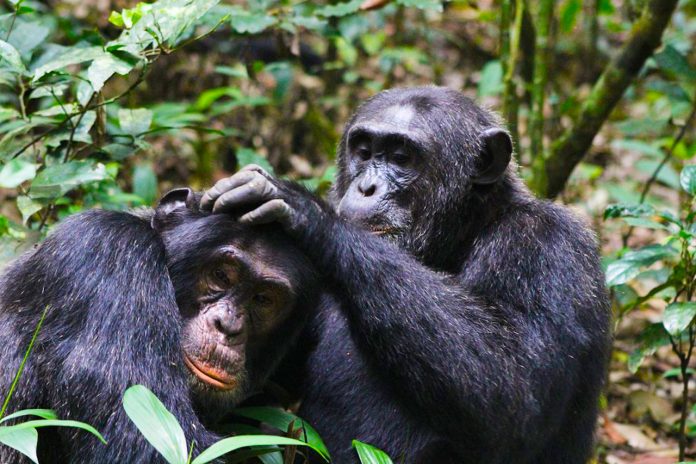The Ngogo Chimpanzee Project is found in Kibale National Park in Uganda and stands as a beacon of dedication to studying and protecting the Ngogo chimpanzee community. The project was founded in 1995 by David Watts of Yale University and John Mitani from the University of Michigan and has been a hub of scientific inquiry and conservation efforts aimed at understanding and safeguarding these magnificent creatures.
The Ngogo chimpanzee community, renowned for its sheer size and remarkable composition. With nearly 200 individuals, including 32 adult males and 50 adult females, this community represents a scale unprecedented in the chimpanzee world. Such a vast community stands in stark contrast to others within Kibale National Park, where populations typically range from 44 to 60 individuals. Even the largest previously documented community, the Mahlae “M Group,” peaked at 114 members before declining an indication of the exceptional nature of the Ngogo community.
The Ngogo community’s sprawling home range, comparable in size to other chimpanzee communities, harbors a population density three times higher, highlighting the unique ecological dynamics at play in this corner of the park. Researchers at Ngogo are tirelessly unraveling the mysteries behind this phenomenon, exploring various facets of chimpanzee behavior, social dynamics, and ecological interactions.
A key focus of research at Ngogo revolves around chimpanzee feeding ecology, shedding light on the critical role of food availability in shaping community size and density. Unlike other sites within Kibale National Park, where certain tree species are scarce, Ngogo boasts an abundance of essential food sources, particularly the giant fig Ficus mucuso. This tree species, with its year-round fruit production, serves as a lifeline for Ngogo chimpanzees, ensuring a steady food supply throughout the seasons.
In addition to observing chimpanzee behavior, researchers diligently collect biological samples for genetic and hormonal analyses, providing valuable insights into the genetic diversity and health of the Ngogo community. Moreover, the project collaborates closely with local communities and law enforcement agencies to combat illegal hunting, safeguarding chimpanzee populations from external threats.

Researchers at Ngogo also play a pivotal role in the process of habituating chimpanzees for tourism, ensuring that these activities are conducted responsibly to minimize disturbance to the animals and their habitat. By providing financial support for local and government-led conservation efforts, researchers contribute to the long-term protection of chimpanzees and their environment.
Despite the remarkable success of the Ngogo Chimpanzee Project, challenges remain. The historical presence of humans in the area underscores the ongoing need for conservation efforts to preserve these invaluable ecosystems for future generations. As a research site, Ngogo continues to provide invaluable insights into forest ecology and chimpanzee behavior, guiding efforts towards sustainable management practices that protect wildlife and their habitats.
In addition to chimpanzees, Kibale National Park is home to a diverse array of wildlife, including several diurnal and nocturnal primate species. These include red tailed monkeys, blue monkeys, L’hoest’s monkey, red colobus, black and white colobus, baboons, and grey-cheeked mangabeys. Vervets occur along the forest margin and in grasslands in some areas. Nocturnal primates include pottos, Demidov’s dwarf galago, and the eastern needle-clawed bushbaby.
Historically, leopards may have hunted chimpanzees in Kibale, but they are no longer present in the area. Instead, Kibale National Park is home to a diverse range of forest-dwelling animals, including various ungulates like blue duikers, red duikers, bushbucks, and bush pigs, which are potential prey for chimpanzees. Additionally, the forest supports a rich array of rodents, birds, and invertebrates that make up the chimpanzees’ diet.
The park also boasts a sizable population of elephants, which play a significant role in shaping the forest ecosystem. Elephants feed on saplings and small trees, affecting the forest’s structure. Their browsing habits, combined with predation by rodents and insects on seeds and seedlings, can hinder forest regeneration, especially in large gaps.












